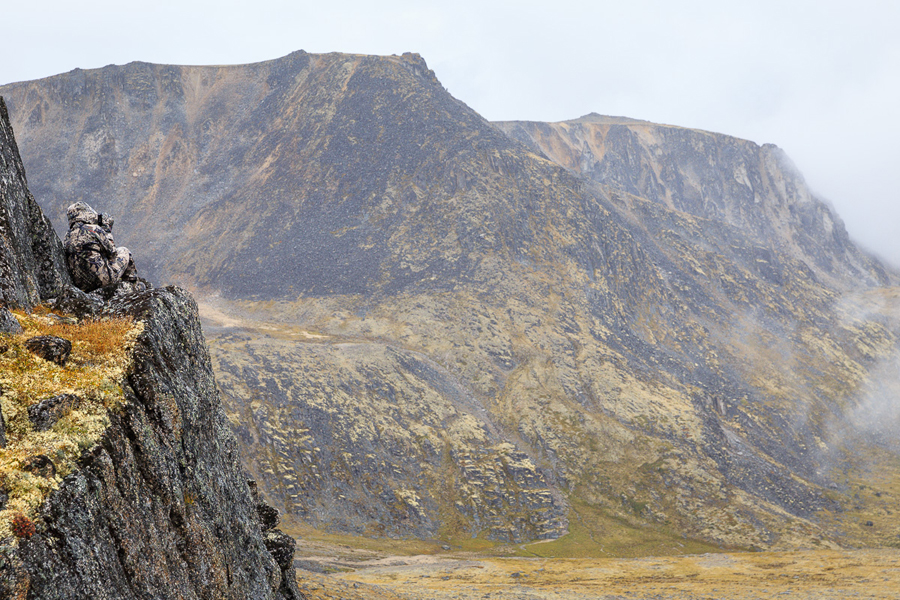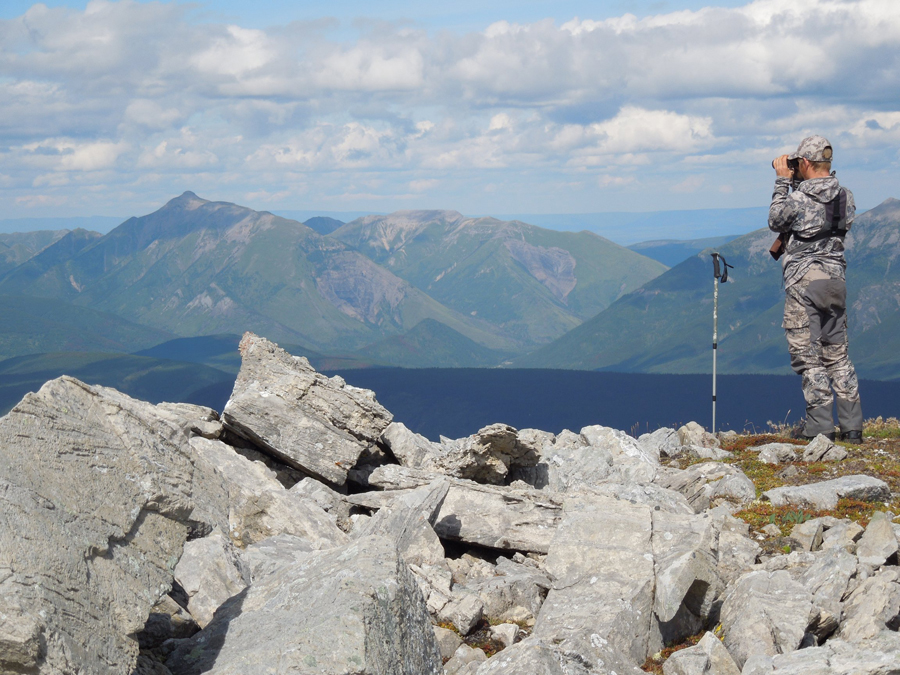What is the most important piece of equipment in your pack? Arguably, it would be your gun or bow, right? But, if we look deeper, beyond the act of killing, it’s your optics. Mountain hunts depend entirely on being able to spot game. That, in my opinion, is the key to whether or not you will be successful on a hunt. More importantly, it’s not just the brand or type of glass we use, but how we use it.
Over the last 10 years I’ve had the chance to hunt with a lot of experienced hunters and guides and every one of them have used different setups and techniques when it comes to picking the landscape apart. None are wrong, but some have definitely worked better than others.
Find’em
Let’s start with our options. Handheld binoculars are a must have, but there is more to it than just having a pair in your pack. 8X binoculars are the most common with hunters coming from the East that typically hunt deer from a stand and rarely need to look past 500 yards. Hunters that live in the West seem to be more experienced with what to expect in the North and typically show up with higher quality, stronger magnification glass.
10X is probably the most common, but we do see 12X and 15X hanging around necks more and more these days. If you aren’t bringing a spotting scope on the hunt, then 12X is the best bet for a handheld setup. 15X, with a tripod attachment, is very effective and this set up has grown on me quite a bit in the last few years. I’ve found that they’re a bit much for my arms to hold for long periods of time without a tripod, but I’ve noticed a big increase in the amount of time I can glass long distances without fatigue using a tripod. For sheep hunting, I personally use 10X Leica Geovids and a Leica spotting scope—if I was tougher I would probably pack a set of 15X binoculars as well. So, now that we have the equipment to get the job done, how do we go about methodically finding them? Is it that simple?
There isn’t really one right way to spot sheep and, really, however you find them doesn’t matter all that much. If you spot them, you’re doing it right! Just like a stalk, you can do it a hundred different ways and, if you kill it, then you did it exactly how you needed to. That’s part of the fun in hunting isn’t it?
Every single mountain is different. Different distances, sizes, cover, species, weather, time of year, etc. Here are a few different scenarios and techniques that may help you find the needle in the haystack.
Let’s look at an early season or summer hunt compared to a late season fall or winter. In August, it’s hot and there are lots of bugs— I hate the bugs! This time of year the sheep will, more often than not, be in different locations than those during a late September hunt, when the bugs have died off, and rain, or snow, is in the air and the temps are colder. Wind is also a big factor that will help determine the location of these mountain ghosts, no matter the time of year or the season. I’ll quickly touch on the most common places to look during these types of conditions.
Summer = Hot and Bugs:
Typically, on hunts like this, you will find the sheep up high on top of, and in, the rocks. The warm summer breeze blows the bugs away and keeps them cool and it also allows them to see long distances to watch for approaching predators. The key factor here is the bugs. If the bugs aren’t bad, then they will also head for the trees for much needed shade on those real scorchers. The time of day plays into all of this as well. Feeding time is a given. They will go to a food source, no matter what at some point, so this is another thing to watch for. Identify likely food sources and parts of the mountain that are likely to hold food and focus on these as well.
Late Fall = Cold, Snow, No Bugs:
When winter is near and you find yourself hunting sheep, you will find that they are not as easy to pick up as they are in the summer. This time of the year they spend a lot more time closer to tree line and in the brush. The hot summer sun has burned off a lot of the vegetation they depend on and they must go lower to find food. Spend more time looking for white butts in the trees and, typically, you’ll need to spend extra time glassing from each and every possible location than you will in the summer. The key times are the first two hours of light and the last two hours. You cannot afford to miss these prime times, especially at this time of year.
So early season glass high and later in the year, or when weather isn’t ideal, glass low and closer to tree line. It’s that simple, right? Well, not really. When I first started hunting sheep all I heard was, “The only thing predictable about a sheep is that they’re unpredictable,” and I have found this to be very true. So glass everywhere!
Now that we’ve touched on places they most likely will be, here are some of the ways I pick the mountains apart.
First, I will sit and use my walking stick as a rest to keep me as steady as possible. This helps you see movement and objects that just don’t seem to fit in. You’re looking for horizontal lines or white spots, butts or legs typically. Anything for that matter, really, that catches your eyes or looks “off” should be investigated. I usually start in close, hoping to see them before they see me, and then move out. I follow the skyline and look for any areas or features that a sheep might want to stay close to. Bluffs, cliffs, benches, chutes, crags or outcroppings, especially if they’re close to food sources, should be investigated thoroughly. These are the places sheep like to walk around or hide in as they can usually be out of sight within minutes. After I have checked these spots, I then scan everything in sight, usually in a grid pattern from left to right (personal preference) before moving down a bit and doing it all over again. Once I have completed the process with my binoculars, I make sure to scan the ridgelines again, just in case something new has appeared.
A quick note: should you find something that catches your attention, one thing that really helps is remembering not to get too excited and take your eyes off it in a rush to get out your optics. Relax, keep your eyes on it and then slowly pick out some other objects that stand out to mark its location—a tree, a distinct rock or peak can really help when you need to find it again in the spotter. I don’t know how many times I, or my clients, have said, “I got one,” only to follow that up with, “Now I can’t find it. I forget where I was looking.”
After covering everything with the binoculars, and depending on the terrain (distance or amount of broken ground), I will then pull out the spotter and do the same thing. This time, however, I go much slower and not only look for objects that catch my eye, but dig deeper looking for pieces of sheep—the horn of a bedded ram, a leg in the trees. I look in an up and down grid pattern. I follow each ridge from top to bottom and every creek valley bottom back to the top. By the end of this you should feel like you know every rock, clump of grass and branch on the mountain. The key to this process is taking your time. Go slow and be thorough. Sheep will bed for hours on end and, if you don’t give it time, you will miss them and move on.
It’s been said before but I’ll say it again, glass, glass and glass some more. The more broken the ground is, the longer you need to stay in one spot. You can try to move to get a different angle on the cracks and crags, but don’t rush the process. Your optics are your best friend and, as tough as it is, stay a bit longer.
Sun direction, wind direction and time of day are also very important things to consider. Sun direction is something you can try and account for, and should think about, when picking your camp location, or even where you may drive your truck to for the morning look. You want to look at the side of the mountain that the sun hits first. More often than not, the sheep will want to catch some morning rays after a long cool night. Your chances of picking up rams will be a lot better when the sun is at your back and hitting them. Usually, this first light is the best time to catch them feeding and moving around in the open. Just like at last light, it’s a time you need to be looking for them. Periodically, during the day, they will get up and stretch and maybe even grab a snack, so be sure to look every chance you can but these first light, last light moments when the sun is in your favour are truly key times.

In my opinion this ability to camp on top is why backpack hunting can be more effective than using horses—of course many people are physically limited and that’s understood. If you camp on top, you will have a better chance of being there during these prime times. Not only will you be on top when the time is right, but you will be able to glass any time you want. When a horse is moving, you’re not glassing. Pick spots to camp that allow you lots of opportunity to look in the right direction while you fix coffee or cook that oatmeal. Throughout the day, when sheep aren’t moving or less likely to be, use this time to move to new locations. Just remember your glasses cover a lot more ground than your legs can. Get high and look often.
Wind can be the biggest factor for NOT seeing sheep, as they tend not to move as much and usually hold tight in gullies, as well as in, or around, trees. This can also be helpful since, if you do find them, it allows you more time to make a perfect stalk. If I had the choice, I’d go with a light, steady wind always. If it’s windy, you will most likely need to be looking into the wind to see them, as they often move to the protected side. Sometimes, this is when you will need to cover more ground on foot. Getting into more basins increases your chances of seeing sheep, but it will usually be a much closer encounter, with less chance for a stalk.
Like I said at the top, there are many ways to spot sheep and by no means am I the best at it. These tactics however work best for me. Sometimes I find them and sometimes I don’t. But one thing’s for sure, I’ll be looking.



